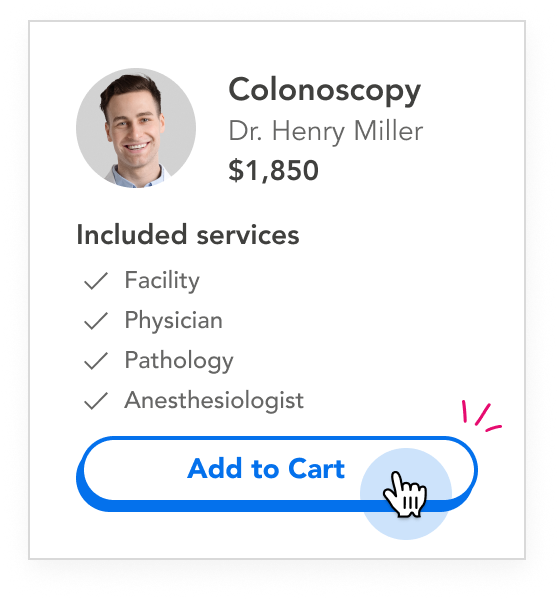2D Mammogram Diagnostic Bilateral (2 breasts) in the Carbondale Region
Save by purchasing this procedure online.
Similar Procedures: 2D Mammogram Diagnostic Unilateral (1 breast), 2D Mammogram Screening, Ultrasound Breast Unilateral (1 breast), Ultrasound Breast Bilateral (2 breasts), Contrast-Enhanced Mammogram Unilateral, Contrast-Enhanced Mammogram Bilateral
National Average 444
Regional Average301Save $143
Financing Options
Promotional financing available when you pay with CareCredit. $200 minimum purchase. What is CareCredit?
Crossroads Community Hospital
Imaging and Radiology Center
4.9
8 Doctors Park Road
Mount Vernon, IL 62864
Offered by

Heartland Regional Medical Center
Imaging and Radiology Center
4.8
3333 West Deyoung Street
Marion, IL 62959
Offered by

Money Back Guarantee
We will refund your payment in full if you end up not needing your purchased procedure and do not receive care. Details
Get Care In Three Easy Steps
Compare Upfront Prices

Search by procedure and location to browse local providers and compare upfront pricing.
Buy Your Procedure

Pay for your procedure online or by calling (844) 256-7696. Or buy your procedure at the facility before your appointment is scheduled.
Receive Your Care

Follow the scheduling instructions given by your provider. Bring your voucher to your appointment.
Frequently Asked Questions
View All FAQs2D Mammogram Diagnostic Bilateral (2 breasts) Cost in the Carbondale Region
Save by purchasing this procedure online.
Procedure Details
What is a Bilateral Diagnostic Mammogram?
A mammogram is an x-ray of the breast used to find tumors or tiny calcium deposits (microcalcifications) that may indicate the presence of breast cancer. Mammography uses special x-ray equipment to hold and compress the breast during imaging, which allows for a sharper picture and lower dose of radiation than standard x-rays. Diagnostic mammograms are used to investigate abnormalities in the breast that may be symptoms of breast cancer. Often, a diagnostic mammogram is a follow-up exam ordered if a screening mammogram detects something out of the ordinary. Diagnostic mammograms may also be used after a lump or other potential sign of breast cancer is felt or found during a breast exam, or in women with a history of breast cancer (particularly those who have had a lumpectomy or recent mastectomy). There are two types of diagnostic mammogram – unilateral and bilateral. Unilateral diagnostic mammograms examine only one breast, whereas bilateral mammograms take images of both breasts.
Why are Bilateral Diagnostic Mammograms Used?
Bilateral diagnostic mammograms may be ordered if abnormalities are detected in both breasts during a screening mammogram, or if a lump or another symptom is felt during a breast exam. In these cases, the diagnostic mammogram can be used to confirm or rule out a diagnosis of breast cancer. In women who have already been treated for breast cancer, the bilateral diagnostic mammogram is especially important because it is taken yearly to check for healing progress or new cancer growth. Many women today opt to treat their breast cancer with breast conserving surgery (also known as partial mastectomy or lumpectomy), which leaves some of the original breast tissue intact. In these cases, unilateral mammograms are usually taken of the affected breast six months after radiation treatment is complete to establish the baseline, and follow-up bilateral mammograms are recommended every year. Bilateral mammograms are also used to follow up after a special kind of breast cancer surgery known as a subcutaneous (or skin-sparing) mastectomy, in which most of the breast tissue is removed, but some original tissue is left intact. Because original tissue remains, both the affected and unaffected breast must be checked yearly.
What is the Difference between Screening and Diagnostic Mammograms?
Screening mammograms are preventive procedures used to check for signs of breast cancer in women who do not have any cancer symptoms. Diagnostic mammograms are used to help diagnose breast cancer when a lump or other symptom has been found. Screening mammograms are performed with a technician present, and usually involve only two images per breast. Diagnostic mammograms are performed with a radiologist and a technician present, and are often combined with an ultrasound. More images are typically taken in a diagnostic mammogram.
Who Should Get a Bilateral Diagnostic Mammogram?
Any woman who has found any symptoms of breast cancer, either through a breast exam or a mammogram, should speak with a doctor about a diagnostic mammogram. For breast cancer survivors who retain original tissue in both breasts, many doctors recommend bilateral diagnostic mammograms every year in place of screening mammograms because of the more in-depth imaging diagnostic mammograms use. If you have had breast cancer surgery, it is important to speak with your doctor or surgeon about what kind of mammogram you should get and how often you should get them.
What Can You Expect During a Bilateral Diagnostic Mammogram?
During your mammogram, you will need to undress from the waist up, but the facility will provide you with a wrap to wear. You will be in the room with a technologist, who will help you position your breast on the x-ray plate. A radiologist will also be present during your mammogram, and may request special images, called spot views or magnification views, to better evaluate any unusual or suspicious areas. In order to get the best possible image, your breast will need to be compressed in the machine. This may be uncomfortable, but each compression should only last for a few seconds, and the whole screening should only last about 20 minutes. If needed, an ultrasound may accompany your diagnostic mammogram, to provide the radiologist another view of your breast tissue. After your mammogram, your facility is required to send you a summary of your results within 30 days.
What does a Bilateral Diagnostic Mammogram Cost?
The cost of diagnostic mammograms can vary dramatically based on insurance plan, the region and facility in which the mammogram is performed, and the type of imaging needed to make a diagnosis. A 2005 study found that among women receiving mammograms, women who needed diagnostic mammograms tended to spend more than twice as much as those who only needed screenings, due to higher imaging costs and the costs of consultation and possible intervention. The out-of-pocket cost of a diagnostic screening today can run from the $100s into the $400s or more., We believe that it should be easy and affordable to get the diagnostic imaging you need. MDsave takes the mystery out of mammogram costs by negotiating bundled, discounted rates that you pay one time, up front, with no surprises. Our negotiated rates can save you more than half off the average cost of a diagnostic mammogram, and our bundled price means that imaging, consultation, and facility costs are already included. Just point, click, and pay. Need to find an affordable diagnostic mammogram near you? Enter your ZIP code or check our map.
Patient Reviews
4.8
What did you like most about using MDsave?
Easy and quick just to pick your categories.
What could we do to improve?
Everything was great!
What did you like most about using MDsave?
Ease of website
What could we do to improve?
Nothing so far
What did you like most about using MDsave?
--
What could we do to improve?
Nothing, great first time experience
What did you like most about using MDsave?
Saving money.
What could we do to improve?
Nothing
What did you like most about using MDsave?
The process was simple
What could we do to improve?
No improvement needed at this time
Procedures
© Copyright 2025 MDsave Incorporated.
All Rights Reserved.



